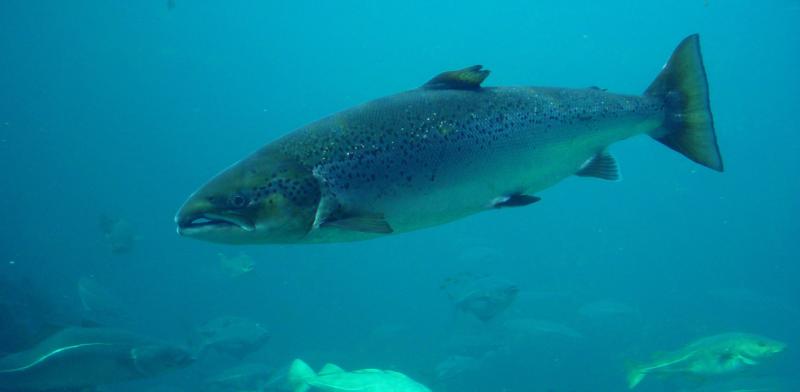Salmon are famous for boldly fighting their way upstream to spawn. But their trip downstream as young smolts is no less heroic. In the case of Atlantic salmon, many must pass through or around dams, and new research reveals that even if they survive the initial hazard, they may suffer injuries that make them more likely to die days or weeks later in the estuary, where the river meets the sea. What’s more, the effects are cumulative: for each dam a smolt passes, its chance of dying in the estuary increases by 6 to 7 percent.
“The effects of dams aren’t limited to a 500-meter stretch below the dam, but extend tens of kilometers out to sea,” said Dan Stich, the lead author of the study, which appeared recently in the journal Marine and Coastal Fisheries. “In fact, the number of fish killed by the delayed effects of dams can be greater than the number killed at the dam itself.”
Atlantic salmon are endangered in the United States, and these findings suggest that making dam passage safer for smolts can help the recovery of the species.
Stich conducted the study as a Ph.D. student at the University of Maine and is now a biologist with NOAA Fisheries. John Kocik, a research fisheries biologist at NOAA and a co-author of the study, said, “We already knew that we were losing a lot of fish in the estuary. Now that Dan’s research has identified some critical mechanisms behind that loss, something can be done about it.”
Toll Booths along the River
For this study, scientists surgically implanted acoustic tags into 941 smolts in the Penobscot River between 2005 and 2013. Those tags emit a coded sound roughly once a minute that uniquely identifies the fish carrying it.
As the fish travel downstream, the sound is picked up by receivers that span the river and the mouth of the estuary. The receivers function like electronic tollbooths, logging each fish as it passes so that scientists can track its progress. When a fish stops moving, it is assumed to have died.
The acoustic tags are about the size and shape of the metal eraser holder on a standard wooden pencil. Experiments have shown that implanting them in the 5- to 7-inch smolts does not harm the fish enough to significantly skew the results of the study.
A Dangerous Passage
At almost 1,000 tagged smolts, this study was the largest of its kind on Atlantic salmon, and it gave scientists enough statistical power to tease apart the factors that influence smolt survival. Of all the variables tested—including temperature, hours of daylight, distance traveled, and many more—one of the factors that most affected a smolt’s chances of survival was the number of dams it passed on its way to the ocean.
In the Penobscot River, most smolts pass dams in sluices or spillways. Those diversions keep most fish out of the generating turbines, but the ride can be rough and leave the fish injured or partially de-scaled. That can make them more vulnerable to predators and less able to withstand saltwater when they first encounter it days or weeks later.
“There are a lot of things waiting in the estuary to eat them,” Kocik said, including cormorants, seals, and striped bass. “Any fish that’s injured is easy prey.”
Timing Matters
As they make their way downstream, the smolts transform into ocean-going fish. They become longer and slimmer, acquire the ability to excrete salt from their gills, and are soon ready to migrate thousands of miles to Greenland.
This study showed that if smolts hit the estuary at peak saltwater readiness, their survival rate increases by up to 25 percent. The study also showed that scientists can estimate when that optimum window opens based on variations in stream temperature. This new understanding has already changed the way hatchery managers time the release of their smolts.
As for the effect of dams on downstream survival, now that it has been measured it can be managed. Two dams were recently removed from the main stem of the Penobscot River. In addition, NOAA Fisheries, the Federal Energy Regulatory Commission, and dam operators are working to aid recovery by making the remaining dams more salmon-friendly.
A large fraction of Atlantic salmon die in the ocean, where little can be done to increase survival. But in freshwater, there are options. In addition to removing dams and improving fish passages, several projects are underway to restore freshwater spawning and rearing habitats.
“The best thing we can do is boost the number of fish going out,” Stich said. “And understanding how dams affect fish survival will help us do that.”


